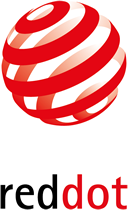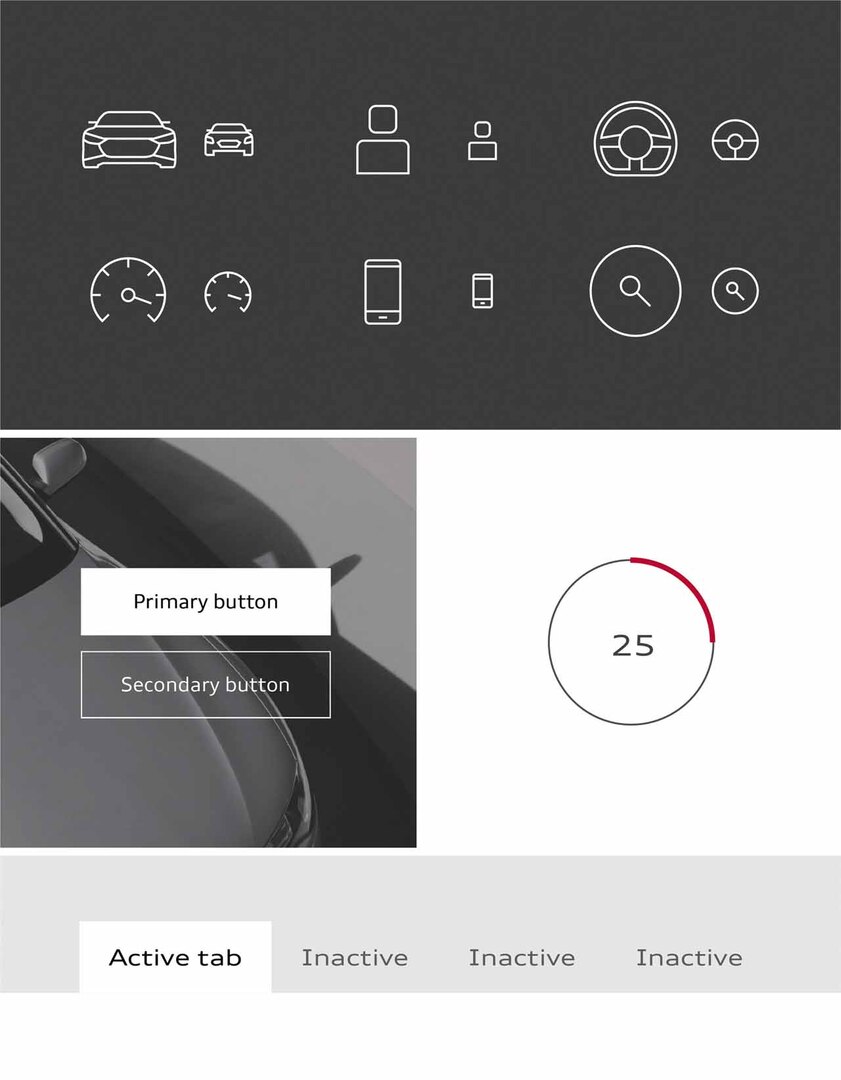About corporate identity, digitisation and the Audi rings: interview with Simone Labonte from Audi, Red Dot: Brand of the Year 2017 (part 2)
In the Red Dot Award: Communication Design, Audi convinced over many years with its significant brand communication, consistent decisiveness in brand management and its effective collaboration with creative partners, such as loved, thjnk, KMS TEAM, BLACKSPACE and STRICHPUNKT DESIGN. In 2017, the automotive manufacturer was thus awarded the honorary title “Red Dot: Brand of the Year” for the fifth time. In the second part of the interview with Red Dot, Simone Labonte, Head of Corporate Identity and User Interface at Audi, talks about the brand’s corporate identity, digitisation and the redesign of the Audi rings.
Ms. Labonte, when you returned to your roots in 2014 as Head of Corporate Identity and User Interface at Audi, did you already have a clear concept of what you wanted to change?
Labonte: When I took over the department, it was still run as classic corporate design. The term “user interface” was added one year later. This change immediately becomes evident when looking at Audi’s new corporate identity. The company had a highly comprehensive set of rules concerning corporate design. This brought with it the difficulty that exceptions had become the rule and that, in turn, those exceptions needed to be regulated. There is no doubt that Audi has a strong CI, but over time this had led to a plethora of rules and just as many exceptions that simply were no longer up-to-date when it came to the digitisation of the Audi brand.
Have the core elements of the brand changed as a result of the digital transformation?
Labonte: The core elements of the brand themselves have not changed, but the way these core elements are handled sure has. What is currently not only perceived by the public but also being discussed very intensively at Audi is how the four rings are being used.
The transition from 3D design to 2D design is unmistakable. Against this backdrop, what does the “Digital First” principle imply?
Labonte: The “Digital First” principle is geared toward the smallest technical device. The CI, the brand’s core elements and the branding must all be tuned to work on a smartwatch, for example. This raises the question of how the four rings can be presented, which otherwise have always been set within a certain framework. However, today’s smartwatches have become so small that the logo is best positioned in the centre of such small displays. Starting with the smallest device, we then transfer these design principles to all other touchpoints of the brand. Whereas the relaunch in 2009 was still clearly marked by an analogue approach, the 2016 relaunch was characterised by a digital approach. And this is why the department runs under the name Corporate Identity and User Interface today: The interface is a key touchpoint in the digital transformation. Without a doubt, it had also been relevant prior to that, but over the past few years interfaces have gained significant importance as they are often at the centre of the first contact with the Audi brand. This implies much more than the colour code and lettering of the brand. A graphical user interface is also part of this, which in turn determines the appearance of the interaction elements. Basically this covers all aspects that we have traditionally not considered in corporate design.
So does this amount to an “anything goes” design approach?
Labonte: No, not everything goes. Yet, the biggest paradigm shift has been the transition from strict CI guidelines to simpler design principles. These design principles are very clearly defined. For example, they do not allow altering the rings. The rings may be trimmed, but they must remain recognisable in their geometry. In this sense, the CI guidelines have successfully shifted into a set of simpler design principles. The Audi brand’s corporate identity platform now features a range of new interaction elements such as the ring size calculator, which makes it much easier for design agencies to determine the required size and spacing of the logo. The ring size is calculated automatically based on the chosen font size. Users no longer have to browse through any of the countless PDF files to determine the correct ring size.
Easier and better at the same time!?
Labonte: With the creative freedom that the changes bring, there is always a bit of uncertainty at the outset about how to apply the new design principles. However, confidence and familiarity grow through the day-to-day use and with the number of successful design examples.
How can the signature and the recognition value of the Audi brand be maintained if the leeway in the design becomes broader?
Labonte: Of course, changes in the design are always accompanied by questions concerning the corporate identity and global consistency of the brand. However, as soon as the designers have developed a basic understanding for the brand, such changes also lead to better quality. Moreover, the creative freedom also helps create more exciting results, which in turn make the brand livelier. CI policies should not be too strict, which may be appropriate and important to achieve global consistency and recognition of the brand, but they should never be allowed to limit the creativity and vitality of the brand.
That sounds paradoxical: on the one hand, designers are responsible for the design of CI guidelines. On the other hand, they are always trying to question stringently defined guidelines.
Labonte: One sure must never lose sight of the brand’s signature and the DNA of the brand. Yet the brand also wants and needs to breath with life. In classical brand communication, overly strict CI guidelines were sometimes deliberately counteracted by the designers.
How does a new understanding develop when applying the fundamental elements of design and communication?
Labonte: The design agencies are strongly called upon regarding this point, because the creative freedom that Audi now offers is very much aimed at enhancing the impact of the overall layout. Alongside the core elements of the corporate identity that characterise the brand – and which we have not changed, such as the Audi lettering and the red, silver and white brand colours – the visual language is an essential element. Today, it is not so much about presenting a vehicle in an artificial environment, but rather about an emotional experience, an experience that emphasises the premium quality of the brand and at the same time promotes a natural, realistic image. And this brings diversity and liveliness to the brand communication.
At Audi, you have been working together with many different agencies. How can you ensure that they understand the new design principles and apply them appropriately?
Labonte: An important basis for a shared understanding is certainly the newly developed CI platform on the Internet, which, alongside the design principles, also provides details aimed at making it as easy as possible for project managers and designers to quickly find solutions in making an implementation. The platform features many elements for easy download and integration into a graphical concept. This fosters the ability to find quick and good solutions.
Could you please expand a bit on the principle of the audi.com/ci Internet platform?
Labonte: Sure. In the past, access to the CI platform was regulated and only possible after registration. This has changed fundamentally. We have made the Internet platform open access, because basically it does not host any secret content. Of course, there is a legal framework prohibiting the external use of the design elements for advertising purposes. Also, the main design principle must be adhered to: “Don’t play with the rings”. So far, we have had very positive experiences with this, because many platform users have thus developed an interest in the brand. For Audi, the platform has become a very important tool. It makes no sense to develop a CI and then not make it available. And there are no more PDF files.
The new Audi CI platform features the brand itself as its content, placing it at the heart of the user experience.
Labonte: Well, the interface becomes the brand. This is exactly what we want to show with the CI platform as a first step. And in thatsense, principles such as “ease of use” and “joy of use” have been andare very important for the development of the platform as a workinginstrument.
Highlights of the interactive CI platform include tools such as the “ring size calculator”, the “TVC ending” and the “icon gallery”. The interactive approach of the tools points towards a brand-defining effect.
Labonte: Yes, the interaction defines the brand. The four rings not only point to the sender of the message, they are the protagonists themselves. Therefore, the rings have also been given a new place in the layout not just to identify the sender or serve as a logo that sits anywhere, bottom right or top right, in the layout. We did the same with the TVC endings. When looking at the TVC endings in detail, it becomes clear that the rings do not simply appear as an additional element set against a black-faded background, but instead become part of the video content itself. The same holds true of the icon gallery for the various touchpoints. If we aim at a comprehensive user experience, we also need a consistent design for the icons, including the ones for the vehicle interiors.
When looking at the design, the trend towards flat design is noticeable. Does Audi follow other major brands like Apple, Google or Amazon in this?
Labonte: The trend towards flat design is not an end in itself but due to digitisation; it’s simply aimed at technically implementing the brand in digital media and making it clearly perceivable. The classic rings in 3D rendition will continue to exist and be used wherever it makes sense: on the vehicles and on buildings. And wherever, for technical reasons, a 2D design is required, we are and will remain true and authentic in presenting the brand.



